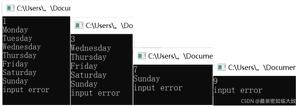在C ++ STL中使双端队列
在本文中,我们将讨论C ++ STL中deque::shrink_to_fit()函数的工作,语法和示例。
什么是双端队列?
双端队列是双端队列,它是序列容器,在两端都提供扩展和收缩功能。队列数据结构允许用户仅在END插入数据,并从FRONT删除数据。让我们以在公交车站排队的类比为例,那里的人只能从END插入队列,而站在FRONT的人是第一个被移走的人,而在双头队列中,可以同时插入和删除数据结束。
什么是deque::shrink_to_fit()?
deque::shrink_to_fit()是C ++ STL中的内置函数,在<deque>头文件中声明。deque::shrink_to_fit()可以将双端队列容器的容量缩小到指定的适合大小,并删除所有超出适合范围的元素。当我们遇到大小问题或容器超出指定大小时,此功能非常有用。
语法
mydeque.shrink_to_fit();
该函数不需要参数。
返回值
此函数不返回任何内容。
示例
Input: deque<int> mydeque = {10, 20 30, 40, 0, 0, 0}; mydeque.shrink_to_fit();
Output:
Size of the mydeque = 40
示例
#include <bits/stdc++.h>using namespace std;
int main(){
deque<int> Deque(50);
cout<<"Initial size of Deque is : " << Deque.size();
Deque.resize(40);
cout<<"\nDeque size after resizing it : " << Deque.size() << endl;
Deque.shrink_to_fit();
return 0;
}
输出结果
如果我们运行上面的代码,它将生成以下输出-
Initial size of Deque is : 50Deque size after resizing it : 4
示例
#include <bits/stdc++.h>using namespace std;
int main(){
deque<int> Deque(10);
for (int i = 0; i <= 5; i++)
Deque[i] = i;
cout<<"Initial size of Deque is: " << Deque.size();
cout<<"\n Deque elements are: ";
for (int i = 0; i <= 7; i++)
cout << Deque[i] << " ";
Deque.resize(10);
cout << "\n After resizing deque size is : "<<Deque.size();
cout << "\n Deque elements are: ";
for (int i = 0; i < 10; i++)
cout << Deque[i] << " ";
Deque.shrink_to_fit();
return 0;
}
输出结果
如果我们运行上面的代码,它将生成以下输出-
Deque elements are: 0 1 2 3 4 5 0 0After resizing deque size is : 10
Deque elements are: 0 1 2 3 4 5 0 0 0 0
以上是 在C ++ STL中使双端队列 的全部内容, 来源链接: utcz.com/z/338377.html







